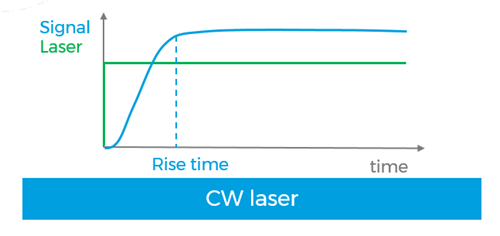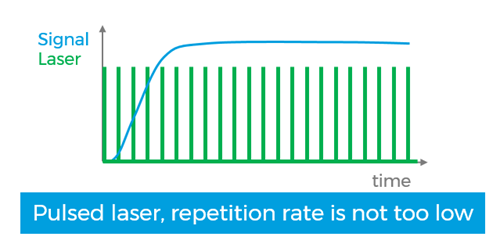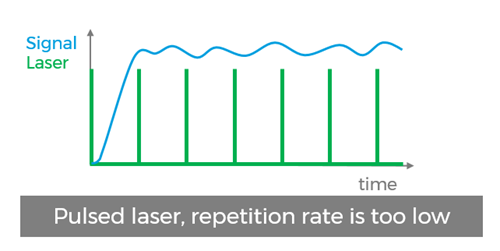What is the minimum repetition rate of a pulsed laser when used with a power detector?
Tuesday, April 06, 2021
Tuesday, April 06, 2021
A recurring question that we hear at Gentec-EO is about the minimum repetition rate that a pulsed laser should have to be properly measured by one of our power detectors. We also ask the same question for energy detectors further below.
Although measuring average power is generally associated only with CW lasers, you can actually also measure the average power of a pulsed laser with a power detector. However, you can imagine that should the repetition rate of your pulsed laser be too low, you could end up seeing the power measurement go up and down between each pulse.



A comparison of how the detector signal (i.e. measurement) will act when the laser is CW, pulsed with sufficiently high rep. rate, and pulsed but with repetition rate that is too low. As you can see, when the rep. rate is too low, the signal goes up and down between each pulse because they’re not coming in quickly enough.
To answer this question, we will need to first differentiate between thermal power detectors and photodetectors.
Ensure you purchase the most optimal solution for your measurement needs with this checklist. Download it now, it's helpful and free!Buyer's checklist for laser power & energy meters
Thermal power detectors are generally much slower than photodetectors, and as such, the minimum repetition rate on thermal power detectors is generally much lower than on photodetectors. Thermal power detectors are therefore better solutions to measure the average power of slow lasers.
Thermal power detectors include our UP and XLP12 series power detectors, such as UP19K-30H-H5-D0. The rule that we recommend to use to determine the minimum repetition rate on a specific model is as follows:
Divide 10 by the rise time of the detector (in seconds): the result is your min. rep. rate (in Hz)
This rule comes from the fact that we recommend to have at least 10 pulses "occur" during the rise time of the detector to not see any fluctuations in the power measurement. For example, with UP19K-30H-H5-D0, we need to have at least 10 pulses occur within 0.6 second, which means the rep. rate of the laser should be no less than 16.7 Hz. As another example, UP55N-300F-H12-D0, with its rise time of 2 s, would have a min. rep. rate of 5 Hz.
If you told us that 10 pulses within the rise time is a bit arbitrary, we would say: yeah, it is, in some way. That’s why, ultimately, your mileage may vary: from our experience, following the above gives the best results to ensure that your power measurements of your pulsed laser show no pulse-to-pulse fluctuations.
Photodetectors work very differently than thermal power detectors, so much so that all of the above information given for the case of thermal power detectors no longer applies. Of course, it had to be completely different, right?
Well, yes. Photodetectors generate and integrate the signal in a different way than power detectors. The minimum repetition rate also depends on the paired meter too, like whether it is MAESTRO, or U-LINK, etc.
We recommend to contact Gentec-EO to find out the minimum repetition rate that your laser should have when measuring with a photodetector, but as a quick rule of thumb, it’s generally at least 1 kHz, and in certain circumstances, it can be as high as 150 kHz. So it’s generally much higher than a thermal power detector, hence why we said at the beginning that you should consider the latter for slower lasers.
Note that using the Moving Average feature in our meters may also help: this function averages power measurements over a certain period of time, enough so that it could remove power fluctuations if your laser has a repetition rate that is too slow for your detector. Consult the user manual of your Gentec-EO meter to find how to enable this feature, when it’s available.
Ok then, what about the minimum repetition rate on energy detectors? Well, there’s none. An energy detector measures punctually the energy of each individual pulse, and as such, as long as the repetition rate is not too high (i.e. above its maximum repetition rate), the detector will just "see" any of the incoming individual pulses.